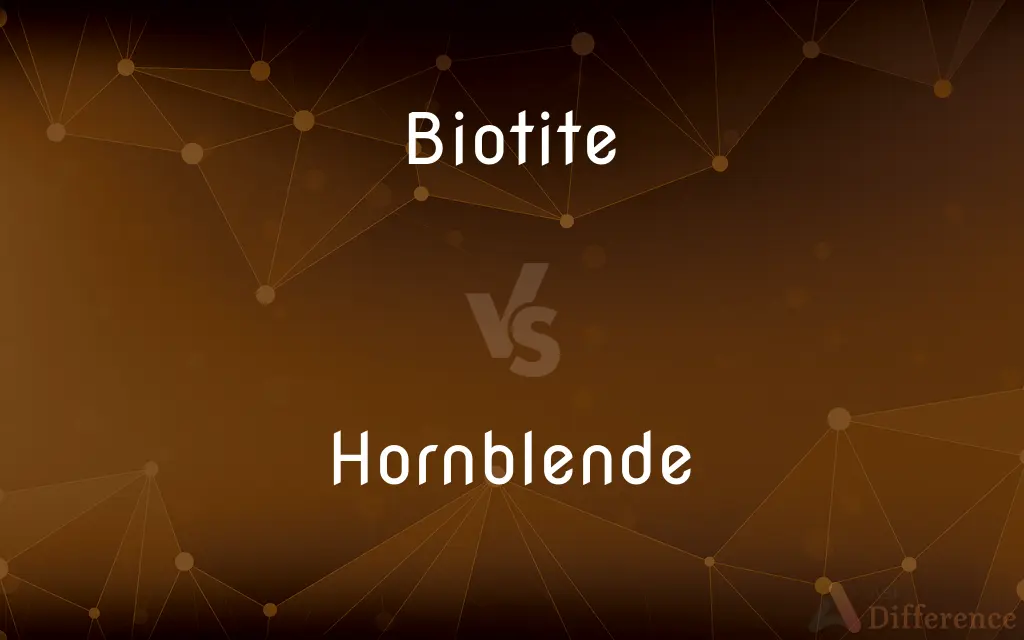Biotite vs. Hornblende — What's the Difference?
Edited by Tayyaba Rehman — By Fiza Rafique — Updated on September 27, 2023
Biotite is a black mica mineral, while Hornblende is a dark amphibole mineral. Both are silicate minerals found in igneous and metamorphic rocks.

Difference Between Biotite and Hornblende
Table of Contents
ADVERTISEMENT
Key Differences
Biotite and Hornblende are two distinct minerals commonly found in various types of rocks. Biotite, belonging to the mica group of minerals, often appears in sheets or flakes and is primarily black to brown in color. Hornblende, on the other hand, is an amphibole mineral that typically exhibits elongated or prismatic crystals, with colors ranging from green-black to brown-black.
Biotite can be identified by its characteristic shiny, layered appearance and is often part of the granite and other felsic rocks composition. Hornblende, contrasting Biotite, shows a vitreous to dull luster and is an essential constituent in many igneous rocks such as andesite and diorite, as well as in certain metamorphic rocks.
Chemically, Biotite is a silicate containing iron, magnesium, aluminum, silicon, oxygen, and hydrogen. Hornblende, while also being a silicate, has a more complex chemistry and can contain calcium, sodium, magnesium, iron, aluminum, silicon, oxygen, and hydrogen. Thus, even at a chemical level, Biotite and Hornblende differ.
The cleavage patterns in these minerals also serve as distinguishing features. Biotite displays a perfect basal cleavage, allowing it to be split into thin sheets. Hornblende has two cleavage directions, intersecting at roughly 60 and 120 degrees, making its cleavage less perfect than Biotite's.
While Biotite and Hornblende are both widespread and significant in geological studies, they have unique properties and appearances that set them apart, facilitating differentiation by geologists and mineralogists.
ADVERTISEMENT
Comparison Chart
Mineral Group
Mica Group
Amphibole Group
Common Color
Black to brown
Green-black to brown-black
Luster
Shiny
Vitreous to dull
Cleavage
Perfect basal cleavage (sheets)
Two directions at roughly 60 and 120 degrees
Typical Rock Presence
Granites and other felsic rocks
Igneous rocks like andesite and diorite; certain metamorphic
Compare with Definitions
Biotite
A dark mica mineral composed of iron, magnesium, and aluminum silicates.
The rock sample contained flakes of Biotite.
Hornblende
A mineral displaying two cleavage directions.
He noted the characteristic cleavage of Hornblende under magnification.
Biotite
Recognized by its shiny, flaky appearance.
Biotite sheets shimmered when light fell on them.
Hornblende
Known for its green-black to brown-black coloration.
The dark prismatic crystals in the andesite were Hornblende.
Biotite
A black to brown phyllosilicate mineral.
Biotite lent the granite its characteristic dark specks.
Hornblende
A complex silicate mineral of the amphibole group.
The dark, elongated crystals in the stone were identified as Hornblende.
Biotite
A common silicate mineral found in various rocks, often in sheets.
He observed the layered structure of Biotite under the microscope.
Hornblende
Commonly found in igneous and metamorphic rocks.
The presence of Hornblende gave the rock its dark hue.
Biotite
A key constituent in many igneous and metamorphic rocks.
The geologist identified Biotite in the rock cross-section.
Hornblende
Exhibits a vitreous to dull luster.
The Hornblende in the sample lacked the shininess of mica.
Biotite
Biotite is a common group of phyllosilicate minerals within the mica group, with the approximate chemical formula K(Mg,Fe)3AlSi3O10(F,OH)2. It is primarily a solid-solution series between the iron-endmember annite, and the magnesium-endmember phlogopite; more aluminous end-members include siderophyllite and eastonite.
Hornblende
Hornblende is a complex inosilicate series of minerals (ferrohornblende – magnesiohornblende). It is not a recognized mineral in its own right, but the name is used as a general or field term, to refer to a dark amphibole.
Biotite
A dark-brown or dark-green to black mica, K(Mg,Fe)3(Al,Fe)Si3O10(OH)2, found in igneous and metamorphic rocks.
Hornblende
The most common mineral in the amphibole group, CaNa(Mg,Fe)4(Al,Fe,Ti)3Si6O22(OH,F)2 commonly green to black, found in igneous and metamorphic rocks.
Biotite
(mineral) A dark brown mica; it is a mixed aluminosilicate and fluoride of potassium, magnesium and iron.
Hornblende
(mineral) A green to black amphibole mineral, of complex structure, formed in the late stages of cooling in igneous rock.
Biotite
Mica containing iron and magnesia, generally of a black or dark green color; - a common constituent of crystalline rocks. See Mica.
Hornblende
The common black, or dark green or brown, variety of amphibole. (See Amphibole.) It belongs to the aluminous division of the species, and is also characterized by its containing considerable iron. Also used as a general term to include the whole species.
Biotite
Dark brown to black mica found in igneous and metamorphic rock
Hornblende
A green to black mineral of the amphibole group; consists of silicates of calcium and sodium and magnesium and iron
Common Curiosities
What is Biotite?
Biotite is a black to brown mica mineral commonly found in various rocks.
Is Biotite a shiny mineral?
Yes, Biotite has a characteristic shiny appearance.
How does Hornblende differ from Biotite in appearance?
Hornblende is typically green-black to brown-black and forms elongated crystals, while Biotite appears in sheets or flakes.
Which rocks commonly contain Biotite?
Biotite is often found in granites and other felsic rocks.
What's the typical color of Hornblende in rocks?
Hornblende usually has a green-black to brown-black coloration.
Which mineral is more resistant to weathering, Biotite or Hornblende?
Hornblende is generally more resistant to chemical weathering than Biotite.
Does Hornblende belong to the mica group like Biotite?
No, Hornblende belongs to the amphibole group.
Can I find both Biotite and Hornblende in the same rock?
Yes, both can coexist in certain rock types like granodiorite.
Do Biotite and Hornblende have the same chemical composition?
No, while both are silicates, they have different chemical constituents.
What kind of rocks typically feature Hornblende?
Hornblende is common in igneous rocks like andesite and diorite, as well as some metamorphic rocks.
Is Biotite found in metamorphic rocks?
Yes, Biotite can be present in various metamorphic rocks.
How can I differentiate Biotite from other mica minerals?
Biotite is usually darker, typically black or brown, compared to other micas like muscovite which is often clear or silvery.
Is Hornblende used commercially?
While not directly used, Hornblende's presence in rocks can influence the rock's overall properties and its commercial applications.
Where can I typically find Biotite in everyday life?
Biotite is often visible as dark flakes in granite countertops or tiles.
How is the cleavage of Hornblende different from that of Biotite?
Hornblende exhibits two cleavage directions, whereas Biotite has a perfect basal cleavage.
Share Your Discovery

Previous Comparison
Dedicated vs. Dedicate
Next Comparison
Maltose vs. AmyloseAuthor Spotlight
Written by
Fiza RafiqueFiza Rafique is a skilled content writer at AskDifference.com, where she meticulously refines and enhances written pieces. Drawing from her vast editorial expertise, Fiza ensures clarity, accuracy, and precision in every article. Passionate about language, she continually seeks to elevate the quality of content for readers worldwide.
Edited by
Tayyaba RehmanTayyaba Rehman is a distinguished writer, currently serving as a primary contributor to askdifference.com. As a researcher in semantics and etymology, Tayyaba's passion for the complexity of languages and their distinctions has found a perfect home on the platform. Tayyaba delves into the intricacies of language, distinguishing between commonly confused words and phrases, thereby providing clarity for readers worldwide.
















































